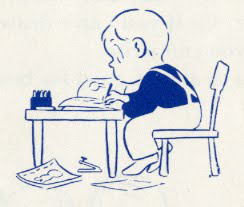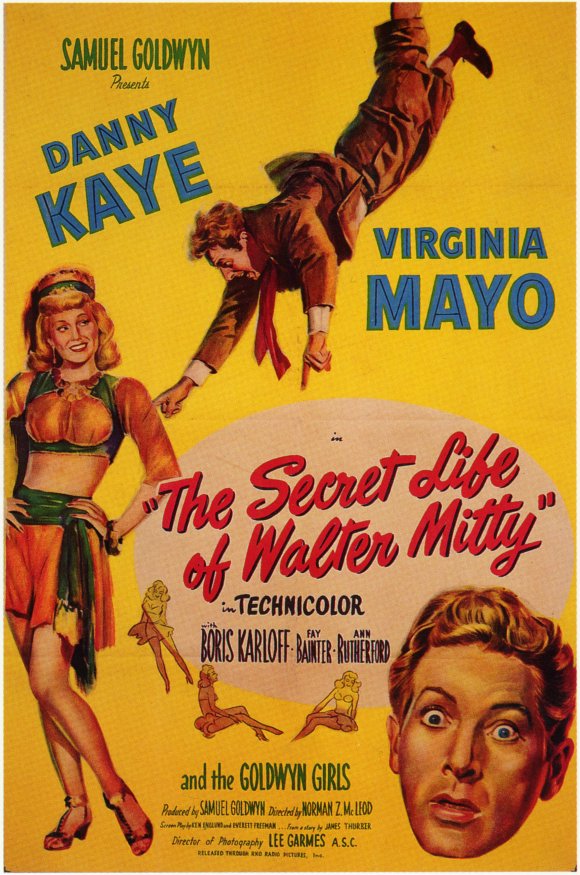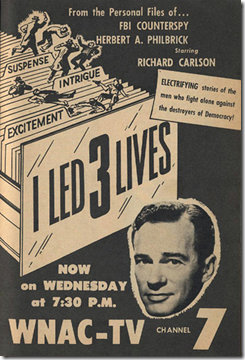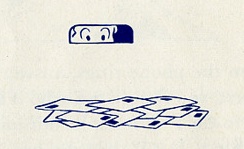 The index and (now proofread!) page proofs for Crockett Johnson and Ruth Krauss: How an Unlikely Couple Found Love, Dodged the FBI, and Transformed Children’s Literature (forthcoming this September) are in the mail, heading back to the publisher. Â To commemorate this occasion, here are yet more cuts and a few other changes –Â most of which I’m fine with, but others of which inspire more mixed feelings.
The index and (now proofread!) page proofs for Crockett Johnson and Ruth Krauss: How an Unlikely Couple Found Love, Dodged the FBI, and Transformed Children’s Literature (forthcoming this September) are in the mail, heading back to the publisher. Â To commemorate this occasion, here are yet more cuts and a few other changes –Â most of which I’m fine with, but others of which inspire more mixed feelings.
First, some cuts! I started sketching categories for the index long before the book went into copy-editing phases; as a result, there were names in my draft of the index that no longer appear in the biography. Here are some of those names and the cuts that prompted their omission.
Abrashkin, Ray
A reference to the co-creator of the Danny Dunn series got relegated to a footnote, then cut altogether. Here’s the footnote version:
Ruth [Krauss] seems to have adapted her book herself: a draft of the lyrics, in her hand, appears on the back of some notes and sketches for Is This You? That said, the Children’s Record Guild’s archives have an unsigned contract that credits Ray Abrashkin for writing the record. Perhaps they collaborated?
I now believe that Krauss wrote the lyrics, though I wouldn’t completely rule out input from Abrashkin. One result of this omission is that the image of The Carrot Seed record now appears … nowhere near the place it’s mentioned in the book. Originally, the record appeared twice in the text, once at the time it was released, and once when W.D. Snodgrass cited it in his essay on the poet’s tact. The latter reference remains, but the earlier one (where the record’s image appears) has gone.  (For more about the Children’s Record Guild, check out David Bonner’s Revolutionizing Children’s Records.  Bonner, incidentally, is my source for that unsigned contract.)
Capote, Truman,
When it went into copyediting, the bio. also included this short paragraph (the “Marc” is Marc Simont, who illustrated four of Krauss’s books):
Ruth and Dave also saw Marc socially. He recalled accompanying them to “a party in Greenwich Village, where a group of young men were doing a farewell party for Truman Capote.” They had prepared “big signs saying ‘Ciao,’” suggesting that the party was in February 1949, when Capote was leaving for Italy. But Capote didn’t show up.
If Capote had shown up, this would have been worth including. He didn’t. So, cutting this makes sense.
Diary of a Nobody, The,
One of Johnson’s favorite books. Since I can work this into one of the Complete Barnaby afterwords, I agreed to omit it from the bio. If I hadn’t had the Barnaby option, then I would have certainly argued that it remain – a writer’s favorite book should be included in the biography of that writer.
Ernst, Max,
Surrealist and father of Jimmy Ernst, who is in the book, as is Jimmy’s spouse, Dallas Ernst.
Flaxer, Abram,
Flaxer was a union organizer and the second husband of Crockett Johnson’s first wife.
Grossmith, George,
Grossmith, Weedon,
The co-authors of The Diary of a Nobody (see above).
Hirschfeld, Al,
In a draft from early May 2011, I still had a reference to Al Hirschfeld, but that disappeared prior to copy-editing phase. The context was Johnson’s early New Masses cartoons (1934-1935):
           Stylistically, Johnson has not yet arrived at the Otto Soglow-esque minimalism for which he is famous. Although the detail is less abundant and the lines more fluid than his earliest work, these lines display more dramatic variations in thickness – beginning thin at an end, and then inflating to show the shadow of an elbow or to accentuate the nape of the neck, before slimming back down to a point. Unlike Crockett Johnson’s characteristic style, these lines often do not close, instead just suggesting the boundaries of a figure. The faces of those whom he satirizes even include elements of caricature. These features bring his early cartoons nearer to that of his contemporary Al Hirschfeld. Johnson lacks Hirschfeld’s delight in rendering minutiae, and uses a lesser degree of exaggeration, but there is an edge that softens in Johnson’s later, characteristic style – a style which would emerge in just a few years, and which he would not alter for the rest of his career.
No trace of this paragraph remains.
Johnson, Lyndon Baines,
The original paragraph provided a little more context for petitions Johnson and Krauss signed:
Before traveling abroad, Dave and Ruth began speaking out at home. Though they likely voted for President Johnson in 1964 (or, certainly, against Senator Barry Goldwater), Dave and Ruth started opposing Johnson’s foreign policy before his new term began. After the North Vietnamese’s alleged attack (which in fact never occurred) in the Gulf of Tonkin, the August 1964 Gulf of Tonkin Resolution gave the president carte blanche to escalate the Vietnam War. Though the vast majority of Americans supported this, Dave and Ruth did not. In late December 1964 or early January 1965, Dave was among the 75 national initiating sponsors of the Assembly of Men and Women in the Arts, Concerned with Vietnam. Joining him were old friends Kay Boyle, Antonio Frasconi, and Ad Reinhardt; New Masses-era colleagues Maurice Becker and Rockwell Kent; and Ray Bradbury, Lawrence Ferlinghetti, Allen Ginsburg, E. Y. Harburg, and Tillie Olsen.
Courtesy of the copy-editor (who, as I say, was charged with doing a lot of actual editing), the final version reads like this:
Before departing, however, they began speaking out against the Vietnam War, which had begun to escalate with the passage of the Gulf of Tonkin Resolution in August. In late December 1964 or early January 1965, Johnson was among the seventy-five national initiating sponsors of the Assembly of Men and Women in the Arts, Concerned with Vietnam. Joining him were old friends Kay Boyle, Antonio Frasconi, and Ad Reinhardt; New Masses-era colleagues Maurice Becker and Rockwell Kent; and Ray Bradbury, Lawrence Ferlinghetti, Allen Ginsburg, E. Y. Harburg, and Tillie Olsen.
In retrospect, I wish I’d pushed back more on this one – and I encountered several such moments in the page proofs. However, the copyedited text arrived with a quick deadline when I was already very, very busy. I did my best, but had I more time to consider, I suspect I would have resisted a bit more. Ah, well. The copyeditor did make many improvements to the text. At the page proofs phase, I of course notice only the changes that I dislike. And I’ve changed some of those in the proofs phase – but only the critical ones, since changes at this stage require more labor from the press.
 Kaye, Danny,
Kaye, Danny,
Reviewers compared Ruth Krauss’s The Great Duffy (1946, illustrated by Mischa Richter) to James Thurber’s The Secret Life of Walter Mitty, which was adapted into a film starring Danny Kaye. The Mitty film (1947), I had written, may be one reason why Krauss’s film treatment of her own The Great Duffy didn’t get picked up. But that’s purely speculative. Mention of her film treatment remains, but the Mitty movie has departed.
Kenny’s Window,
The first book written and illustrated by Maurice Sendak. Introducing the reviews of Ruth Krauss’s I Want to Paint My Bathroom Blue (which he illustrated and which was published the same year), I had the following sentence: “Much praise went to Sendak, whose first picture book, Kenny’s Window (1956), won an honor award from the New York Herald Tribune Book festival that spring.” That’s gone, and so is the need for this reference in the index.
Leask, Alexander,
A reference to an ancestor of David Johnson Leisk (Crockett Johnson). I originally had a whole paragraph on this guy. That got condensed to a passing reference here (David Sr. is Crockett Johnson’s father, and this scene takes place in the 19-teens):
At home, while the nieces played piano, David Sr. sang along, carrying the bass part on tunes like “Mother McCree” and “My Bonnie Lies Over the Ocean.” The latter is a Scottish song allegedly composed by supporters of Charles Edward Stuart (“Bonnie Prince Charlie”) – the son of James Edward Stuart, whom Dave’s ancestor Alexander Leask supported two hundred years earlier
The first sentence remains in the book; the second sentence has been cut. So, in this case, we’ve gone from a paragraph to a sentence fragment to… nothing!
A lot of family members have (wisely) been cut:
Leask, Arthur (CJ’s great-great grandfather),
Leask, Christina (CJ’s aunt),
Leask, John (CJ’s uncle),
Leask, Robert (CJ’s uncle),
Leask, Thomas (CJ’s uncle),
Leask, Thomas James (CJ’s great grandfather),
Leask, William (CJ’s distant ancestor),
Leisk, Ella (CJ’s cousin),
I was able to assemble quite a thorough genealogy of Crockett Johnson, but how interesting is this? To me, very. To others, not as much. So, it’s gone.
Masses, The,
Art Young was a mainstay of The Masses, but also contributed to New Masses while Johnson was editor. Young is still in the book, but the reference to his earlier career has left.
McCrea, Joel,
In a discussion of a 1948 Barnaby narrative, I’d invoked the great Preston Sturges film Sullivan’s Travels (1941, starring Joel McCrea) as a point of comparison. The entire paragraph is gone, but a version of it will return in The Complete Barnaby, Vol. 4: 1948-1949.
Mencken, H. L.,
I’m completely fine with this cut. Krauss studied violin at the Peabody Conservatory of Music – Mencken was a frequent visitor at the time. Himself a pianist, he was also friends with Gustav Strube, Peabody teacher (and conductor of the newly established Baltimore Symphony).  And he knew some of Krauss’s teachers at Peabody, too. This deserved to be cut because the connection to Krauss is far too tenuous: sure, she likely attended the same symphony concerts as Mencken, and may have been aware of his Peabody connections. But these connections are not sufficient to keep Mr. Mencken in.
 Philbrick, Herbert,
Philbrick, Herbert,
I had a very brief reference to Mr. Philbrick (itself condensed from an even longer mention). It appeared in the context of the FBI’s monitoring of Johnson:
As Herbert Philbrick notes in his memoir, I Led Three Lives (the basis for the Emmy-nominated TV series, 1953-1956), being a successful informant requires convincing the Communists of one’s loyalty: obvious visits from federal agents would give the game away.
Is it necessary? Â No. Â And so, it’s gone.
Psychoanalyst and the Artist, The,
Book by Daniel E. Schneider, Ruth Krauss’s psychoanalyst –Â the biography still includes a brief quotation from the book, but its title is now relegated to a citation.
Schwed, Peter,
Johnson was friends with Fred Schwed, Peter’s brother. But Peter – a Simon & Schuster editor – appeared in the context of his fellow Simon & Schuster editor Jack Goodman. Goodman & Fred Schwed remain in the book, but Peter’s gone.  Incidentally, Fred Schwed is author of the classic satirical look at Wall Street, Where Are the Customers’ Yachts? (1940, repub. 1955).
Searchinger, Marian,
Spouse of documentary filmmaker Gene Searchinger. The Searchingers went on a vacation with Johnson and Krauss in the early 1950s, but that trip got cut. Gene Searchinger is still in the book, though. A number of his conversations with Johnson were quite illuminating. I was saddened to discover, a few months ago, that Mr. Searchinger passed away in 2009. I really enjoyed talking with him, and I think he would have enjoyed the biography.
Zigrosser, Carl,
In 1938, New Masses was planning an art supplement, thinking that such a feature might draw in more readers. Johnson and contributing editor Herman Michelson went to the Weyhe Gallery to talk to Carl Zigrosser about this. This entire paragraph has been cut. Incidentally, someone looking for a project should consider publishing either all of or simply extracts from Zigrosser’s diaries. I read them on microfilm in the Smithosnian’s Archives of American Art. Meticulous, and fascinating. Zigrosser knew everyone.
Zindel, Paul,
Ruth Krauss and Crockett Johnson went to parties thrown by Willard Maas and Marie Menken. So did Andy Warhol and Paul Zindel. Warhol’s still in the book, but the copy-editor cut Zindel. I let it stand, but now doubt that decision.
The changes that inspire the most mixed feelings are stylistic. The copy-editor – who was also charged with editing the manuscript – made many helpful changes, which were valuable (and necessary) for reigning in my large manuscript.  Indeed, you can see many of the good changes in the list above, and in previous posts on this process.  In the copy-editing phase, I pushed back against some suggestions, and let others stand. As noted above, the copy-edited manuscript arrived with a quick deadline when I lacked time to go through it with the degree of specificity I’d have preferred. I did my best, but while reading the proofs I noticed some changes I wish I’d caught. I was able to correct some of them, but others had to remain.  With apologies to the copy-editor, these are some of the copy-editor’s changes that most rankled:
- Adding passive voice. I suspect that this may from the copy-editor’s training in history, although I cannot say for certain. I use passive only very rarely. I restored most of my active voice, but sometimes let passive sentences stand.  In the proofs, I caught a number of instances in which traces of both sentences were there.  When I caught them, I crossed out the passive verb so that the text made sense.  I suspect, though, that I may have missed some.
- Making my sentences needlessly long. I suspect that this, too, may derive from the copy-editor’s training in history – but I’m not sure.  My response may simply derive from the fact that I resist this trait common to an academic style. I dislike long, twisty academic sentences, and so I try to avoid them whenever I can.
- Making my paragraphs needlessly long. I really want the book to have paragraphs of manageable length.
- Cramming all the dialogue together in a single paragraph instead of treating it as dialogue. Where possible, I’ve separated conversations out again.
- Cutting dialogue all together. Dialogue helps create character. Some of the conversations were clearly not neccessary. But others,… I’m not so sure. For example, I wish I’d retained more of Krauss’s last conversation with Sendak.
If I could have had a novelist (instead of an historian) as my copy-editor, that would have been ideal: I want this to read more like a novel, and less like a history. But, of course, I focus here on the changes that rankle because I forget the many (many!) beneficial changes instituted by the copy editor – who, let me repeat, made some very helpful suggestions. I also focus on these things because I’ve been working on this book for over a dozen years, and (given that massive investment of time and energy) I want it to be the best that it can be. In sum, I focus on these things because I’m a perfectionist and thus have a hard time letting things go!
 Anyway. Enough obsessing. It’s done. As I mentioned at the top, the marked-up page proofs and the index are on their way back to the publisher. And the biography will be out in the fall! Even better, you won’t have to read yet another blog post in which I discuss writing the biography. Probably.
Anyway. Enough obsessing. It’s done. As I mentioned at the top, the marked-up page proofs and the index are on their way back to the publisher. And the biography will be out in the fall! Even better, you won’t have to read yet another blog post in which I discuss writing the biography. Probably.
Far, far too many posts on this blog relate to the writing of this biography. Â Believe it or not, the list below does not even contain all such posts. Â So, depending on your tolerance for tedium, you might proceed at your own risk here:
- The Joy of Index (Feb. 2011)
- Crockett Johnson and Ruth Krauss Biography: Final Cuts, Part 3: Does This Make My Manuscript Look Fat? (Dec. 2011).
- Crockett Johnson and Ruth Krauss Biography: Final Cuts, Part 2: The Dog Problem (Dec. 2011).
- Crockett Johnson and Ruth Krauss Biography: Final Cuts, Part 1: What’s in a name? (Nov. 2011).
- Appendix A: American Committee for Spanish Freedom (July 2011).  I cut all four appendices.  This is the first one.
- Appendix B: We Are for Wallace (July 2011).  And this is the second one.
- Appendix C: Assembly of Men and Women in the Arts Concerned with Vietnam (Sept. 2011).  The third one.
- Appendix D: End Your Silence (Sept 2011).  The fourth one.
- Preview: biography of Johnson and Krauss.  First sentence and last sentence (Sept. 2011).
- Invent Title for My Book, Win Signed Copy of the Book (Aug. 2011).  Editor dislikes title.  I “crowdsource” it to readers, and get lots of suggestions.  Have submitted leading contenders to editor.  No decision as yet on final title.
- Crockett Johnson and the Purple Crayon: A Life in Art (Aug. 2011).  My 2004 Comic Art article on the life of Crockett Johnson.  Now available for free as either pdf or a series of jpgs.
- Going Back to High School – 90 Years Back (Aug. 2011).  A glimpse into Crockett Johnson’s high school days.
- He Was a Teenage Harold: Crockett Johnson’s High School Cartoons (Aug. 2010).  Johnson’s earliest work, published under his given name of David Johnson Leisk.
- The Text’s in the Mail (June 2011): in which I send the final version of the manuscript to my editor.
- News, Thanks, and Apologies (May 2011): in which I apologize for the post below, and indicate my current plan of action.
- Update, Featuring First 5 Paragraphs of the Book! (May 2011): ill-advised post, in which I express irritation and conflicting signals from editor.  I shouldn’t have posted this.
- On a First-Name Basis with People I’ve Never Met (Jan. 2011): early version of bit I added to intro.
- biography outtakes, part 8Â (June 2011): now featuring despair!
- biography outtakes, part 7Â (June 2011): killing my darlings. Â Some bits that I like but that do not need to be retained… and thus have been cut!
- biography outtakes, part 6Â (May 2011): some of the notes removed from this current round of editing.
- biography outtakes, part 5Â (Dec. 2010): this and those below are from the round of edits I did in the fall. Â In that round of editing, I removed 10,000 words.
- biography outtakes, part 4Â (Nov. 2010).
- biography outtakes, part 3Â (Nov. 2010).
- biography outtakes, part 2Â (Nov. 2010).
- biography outtakes, part 1Â (Nov. 2010).
Posts tagged Crockett Johnson, Ruth Krauss, or Biography may also be of interest.

Alison Murray
Philip Nel